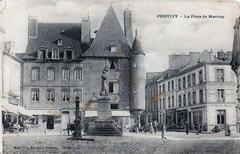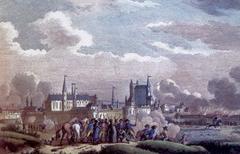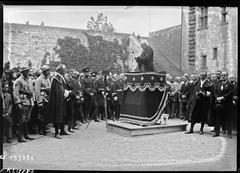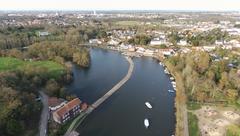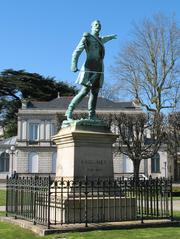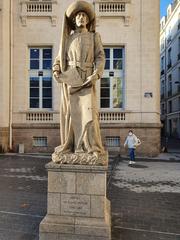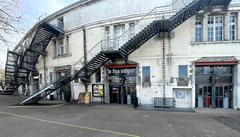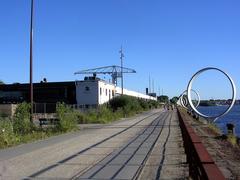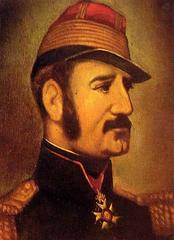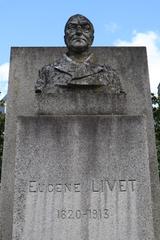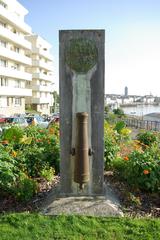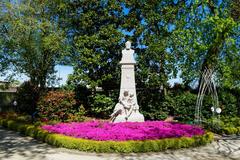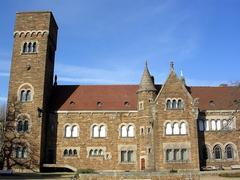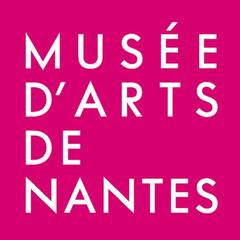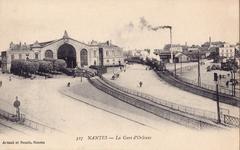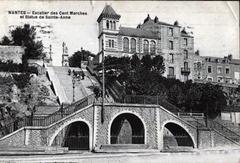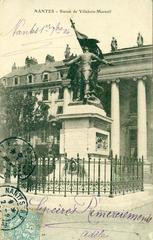Les Otages Nantes: Comprehensive Visiting Guide, Historical Context, and Practical Tips
Date: 14/06/2025
Introduction
Les Otages, also known as the Monument aux Cinquante Otages, is one of Nantes’ most significant historical landmarks. Located along the Cours des 50 Otages, this open-air site commemorates the execution of 50 hostages by Nazi forces during World War II. The monument stands as a testament to the resilience of the local population and the enduring legacy of the French Resistance. Its prominent location makes it easily accessible, providing a place of reflection, remembrance, and cultural significance for both residents and visitors alike. (metropole.nantes.fr; nantes-tourisme.com; monumentum.fr)
Historical Background: The Assassination of Karl Hotz and the Nazi Reprisals
On October 20, 1941, the assassination of German officer Karl Hotz by French resistance fighters in Nantes triggered a brutal reprisal by Nazi authorities. Adolf Hitler demanded the execution of hostages in retaliation. As a result, 50 French hostages were executed—many of them local resistance members, communists, and unionists. The executions took place at Châteaubriant, Nantes, and other locations, marking one of the most tragic episodes of the German occupation in France. This atrocity deeply impacted the collective memory of Nantes and became a rallying point for postwar commemoration. (metropole.nantes.fr; navaway.fr)
The Monument aux Cinquante Otages: Symbolism and Design
Inaugurated on October 22, 1952, the Monument aux Cinquante Otages is a 13.5-meter-high obelisk created by architect Marcel Fradin and sculptor Jean Mazuet. The memorial features five copper lances and two allegorical female sculptures symbolizing the Resistance and the hope of Renaissance France. Names of the executed hostages are inscribed, with additional plaques added over time to ensure historical accuracy and inclusivity. The monument is a protected historic site and a focal point for public remembrance. (Visites Guidées; France 3)
Visiting Les Otages: Hours, Tickets, and Accessibility
- Location: 1 Place du Pont Morand, along the Cours des 50 Otages, central Nantes.
- Visiting Hours: The monument is outdoors and accessible 24/7, with no entrance fee.
- Guided Tours: Available through the Nantes tourism office and local operators, especially during cultural events like Voyage à Nantes. Advance booking is recommended in peak seasons.
- Accessibility: The site is fully accessible for visitors with reduced mobility. The nearby “50 Otages” tram stop (Line 2) ensures convenient public transport access. The area is pedestrian-friendly and integrated into Nantes’ city center. (nantes-tourisme.com)
Annual Commemorative Ceremonies
Every year, commemorative ceremonies are held on or around October 22, the anniversary of the executions. These events feature wreath-laying, reading the names of the hostages, and moments of silence. In 2018, updated plaques were unveiled to honor previously omitted victims, reflecting Nantes’ ongoing commitment to historical accuracy and remembrance. Local officials, veterans, descendants, and the public actively participate in these ceremonies, reinforcing the monument’s role in the city’s collective memory. (France 3)
Cultural Significance and Urban Integration
The executions and subsequent commemoration deeply influenced Nantes’ civic identity. The Cours des 50 Otages, renamed in 1944, is now a vibrant boulevard hosting festivals, public art, and civic events. The monument is a key stop on Nantes’ “green line”—a 24-kilometer trail guiding visitors through major attractions. During the annual Voyage à Nantes festival, the site is featured in thematic tours and artistic installations, integrating remembrance into the city’s cultural life. (patrimonia.nantes.fr; Loire Lovers)
Practical Visitor Information
Getting There
- By Train: Nantes TGV station is within walking distance or a short tram ride. (Loire Lovers)
- By Air: Nantes Atlantique Airport is 10 km away, accessible via shuttle bus.
- By Tram/Bus: TAN public transport serves the area, with tram line 1 and multiple bus routes stopping nearby.
- By Bike/Foot: Nantes is walkable and bike-friendly, with city bike rental stations close to the monument.
Accommodation and Dining
- Hotels: Options range from budget to boutique, with Hotel Le Petit Duquesne and others nearby. (Hotel Le Petit Duquesne)
- Dining: The area offers classic brasseries, creperies, Michelin-starred restaurants, and cafés, especially in the Bouffay district.
Facilities
- Public restrooms and tourist information are available in the city center.
- Accessibility: Most public spaces and the monument are wheelchair accessible, though older buildings may have limitations.
Nearby Historical and Cultural Sites
- Château des ducs de Bretagne: Medieval castle and museum.
- Nantes Cathedral (Cathédrale Saint-Pierre-et-Saint-Paul): Stunning Gothic architecture.
- Memorial to the Abolition of Slavery: A site of national significance.
- Passage Pommeraye: Historic shopping arcade.
- Les Machines de l’Île: Mechanical creatures and artistic installations.
These attractions are within walking distance, offering a comprehensive exploration of Nantes’ heritage. (Voyage Tips; Le Voyage à Nantes)
Events, Photography, and Travel Tips
- Best Time to Visit: Early morning or late afternoon provides optimal lighting and fewer crowds.
- Photography: The monument, tree-lined boulevard, and green line markers are ideal for photos.
- Safety: Nantes is generally safe, but stay vigilant in crowded areas.
- Climate: Mild oceanic, with occasional rain; bring an umbrella year-round.
Educational and Digital Initiatives
Nantes supports educational outreach and digital resources through platforms like Nantes Patrimonia, offering podcasts, archival content, and virtual exhibitions. The 80th anniversary of the executions featured major exhibitions and digital commemorations, and local schools incorporate site visits into their curricula.
Frequently Asked Questions (FAQ)
Q: What are the visiting hours for Les Otages?
A: The monument is outdoors and accessible at all times, 24/7.
Q: Is there an entrance fee?
A: No, visiting is free of charge.
Q: Are guided tours available?
A: Yes, through the tourism office and local agencies, especially during cultural festivals.
Q: Is the site accessible for people with disabilities?
A: Yes, the monument and surrounding area are wheelchair accessible.
Q: What is the main commemorative event?
A: Annually on or around October 22, marking the anniversary of the executions.
Q: What other historical sites are nearby?
A: Château des ducs de Bretagne, Nantes Cathedral, and the Memorial to the Abolition of Slavery.
Summary and Visitor Recommendations
Les Otages is central to Nantes’ memory, symbolizing resistance and sacrifice. The monument and Cours des 50 Otages offer not only a moving tribute to the past but also a vibrant space for cultural engagement and reflection. With its central location, accessibility, and integration into city life, the site is ideal for history enthusiasts, cultural tourists, and casual visitors alike. Enhance your experience by exploring nearby historical sites, attending commemorative events, and using digital resources for deeper understanding. For up-to-date information on events, tours, and exhibitions, visit the official Nantes tourism website and consider the Audiala app for curated itineraries and audio guides. (France 3; levoyageanantes.fr; patrimonia.nantes.fr)
References and Further Reading
- ‘Visiting Les 50 Otages in Nantes: History, Tickets, and Travel Tips’, 2025
- ‘Les Otages Nantes: Visiting Hours, History, Tickets, and Visitor Guide’, 2025
- ‘Monument aux Cinquante Otages Visiting Hours, Tickets, and Nantes Historical Sites: A Comprehensive Guide to Commemoration and Cultural Heritage’, 2025
- ‘Annual Commemorative Ceremony Coverage’, 2025, France 3
- ‘Cours des 50 Otages Visitor Information’, 2025, Hotel Le Petit Duquesne
- ‘Le Voyage à Nantes Official Site’, 2025
- ‘Patrimonia Nantes: Cultural and Educational Resources’, 2025
- ‘Loire Lovers: Visit Nantes Guide’, 2025
